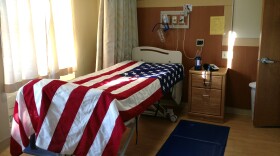Throughout history, the eagle has symbolized strength and courage.
It’s been called “the king of the skies” and in mythology it was often a messenger for the gods.
And now the eagle is also becoming a symbol of gratitude.
Military veterans on the Western Slope are handcrafting canes decorated with the head of an eagle for fellow veterans.
GaryGrattonleans over a lathe. He’s sanding a piece of basswood shaped like an eagle’s head.
Grattonretired from the Marines as an officer. He spent some of his career fighting in Vietnam.
"I’ve spent 27 years serving my country," he says. "NowI want to serve my community."
Grattonvolunteers at the in Montrose.
There he helps coordinate the Eagle Head Cane Program.
It started three years ago when a woodworking group from Grand Junction askedGrattonand other Montrose woodworkers to help make canes for veterans in the area.
"We learned about the program and thought it was just super," he says.
Now Montrose has its own program.
Grattonsays the idea of making these eagle head canes came from woodworkers in over a decade ago.
"As people learn what’s going on it’s being spread all over the country now," he says. "I was down in Arizona and was carving with a guy from Pennsylvania and one from Texas. And they've started the cane program in their neighborhoods."
It can takeGrattonup toeight hours to craft an eagle head.
It all starts with a square block of wood.
"From that block you take away everything that don’t look like an eagle," he jokes.
Grattonsands, carves and sometimes paints the heads.
He works closely with his friend Bob Hampton, an Army veteran, to complete a cane.
Hampton makes the shaft.
"The same cane is not going to work for everybody so we’ve come up with a rough figure," he says. "We take a person’s height and I take half of the height and add a half inch. And that way if it is too long we can cut it down."
Hampton makes the shafts from maple, walnut or elm. Then he engraves a veteran’s rank and name along with their branch of service, job title, unit number and where they were stationed on it.
A veteran can apply for a cane or a family member or friend can also fill out an application for them at the Warrior Resource Center.
Once a month, the completed canes are presented to veterans during a ceremony at the center.
"The first time I tore my left ankle was in a training incident in...Germany," Paul Pyles says. "I was running away from the OP force, the people who were helping to train us to fight in the war. And then the second time I was walking in Iraq and found a weapons cache with my foot."
Pyles is an Army vet who served in Iraq.
He received an eagle head cane made byGrattonand Hampton.
Pyles says he plans to use it everyday.
"I like walking around and hiking," he says. "And I’m always using a Trek poll or something to get around. Now I have a personalized cane that’s mine. It has a lot of symbolism."
Back in his garage,Grattonis putting the finishing touches on one of his eagle heads.
"Well counting the ones I threw away that I didn’t like, I’ve probably carved about 250 of them," he says. "So we’ve given out 200 canes [or so]."
Grattonsays each cane is a custom fit and make.
"I really like the results that come from [the program]," he says. "People just honor these canes. They hang them over their fire places. They put them in decorative areas. They carry them around all of the time. And I just enjoy the people that enjoy those canes."
Copyright 2020 KVNF - Mountain Grown Community Radio. To see more, visit . 9(MDAxNDQ2NDAxMDEyNzU2NzM2ODA3ZGI1ZA001))






